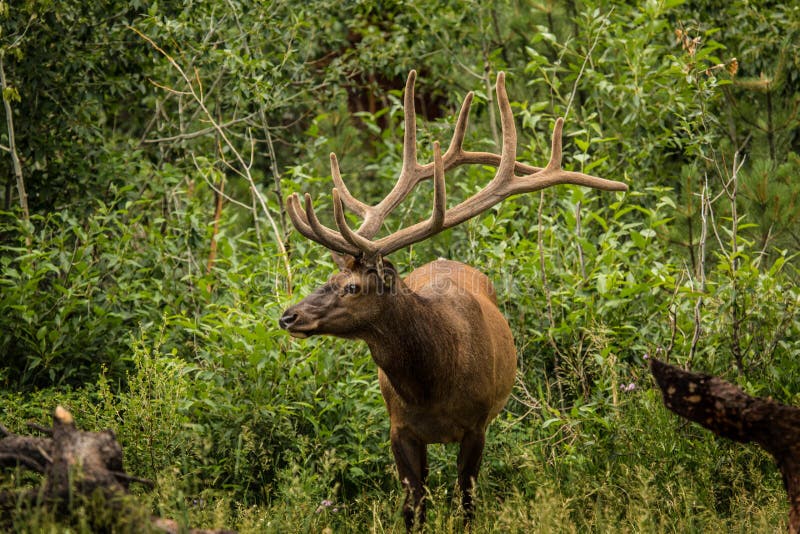
Male herds, because they don't include offspring, are generally smaller and more fluid, with members coming and going. The antlers allow them to protect themselves from predators, but weakened bulls will join up early, before their antlers fall, and enjoy the safety of a group. Male elk may stay alone for awhile after the rut, as long as their antlers stay. Feasting on freshly sprouted greenery is key to the elk replenishing itself after the harsh winter, during which they may loose up to 250 pounds. When spring is near, the females in charge begin to head towards valleys where seasonal grasses will soon emerge. In the winter months, elk must be near forested areas with many trees for cover, and also to strip the bark. Migrating is an important tool in the elks survival, and timing is critical. These include their youngsters from the year before, and are usually guided by a few older members who decide where to graze, when to rest, and when to start migrations. In late winter and spring, herds of elk, called gangs, are divided by sex.įemales may congregate in huge gangs with several hundred members. Today, however, elk populations are healthy, and number close to one million animals across Canada and the United States.Įlk are generally peaceful, social creatures that live together in large herds and cooperate to protect themselves from predators. The Lakota people believed the spirit of the elk brought wisdom and courage to them, and was a symbol of potency.Īfter European settlers arrived, and with the increase in farming, the elk population dwindled, and by the early 1900's, only about 90,000 elk remained. The Lakota Sioux also treasured the elk, and male babies were awarded elk ivories to bring long life and prosperity. They were a vital part of the lives of native Americans, who fashioned elk bones and elk antlers into various tools, weapons and decorations, made clothing and tents from elk hides, and consumed or cured elk meat to survive. The North American elk is also called a wapiti, which means "white rear" in the language of the Shawnee Indians, and refers to the distinctive, beige area of fur surrounding the elks tail. The springtime migration of elk may bring together thousands of animals into one massive herd as they seek out green pastures.Įlk range across much of North America, where they once numbered nearly ten million individuals. In the spring, they tend to look a little shabby as the fur falls out and is replaced by their rich, single-layered coppery colored summer coat.Įlk are social animals who live in same-sex herds of 10 to 20 individuals, that are loosely structured, and may come together in much larger groups, particularly as they migrate to higher ground. The adaptable elk also grow double coats for winter time that are lighter in color than their summertime garb, to help them blend in.

This is called "chewing cud", and it helps large animals to survive on meager rations.

After the food has mellowed, the rumen sends balls of partially digested food back up to the mouth, where the elk will continue to chew it, before finally swallowing it again. When food is initially swallowed, it is stored for a few hours in the first stomach chamber, called the rumen. They are ruminants, just like cows, and have a four-chambered stomach that allows them to digest lots of vegetation that has little nutritional value.ĭuring winter months, they may strip the bark from trees, and eat moss, twigs and acorns. It is thought that when the elk developed antlers as a weapon, it no longer had a need for the tusks.Įlk are adaptable, tenacious, herbivores that eat a large variety of plants, and can exist in many habitats from deep forest to arid, near-desert conditions. There are small deer species in existence today who still have long tusks, but they don't have antlers. Scientists believe these teeth were once 8 inch long tusks, similar in appearance and direction to those of a walrus. Females and even youngsters of some northern subspecies may also have manes.Įlk also have two large teeth in the upper jaw called ivories, whistlers or buglers. Males grow a huge pair of antlers, and have a mantle of dark fur around the neck. The elk is reddish brown in color, with a beautiful wedge-shaped head, and large, expressive eyes and ears. A mature male elk may stand over 5 and a half feet at the shoulder, and the largest will top nearly 1100 pounds.


 0 kommentar(er)
0 kommentar(er)
